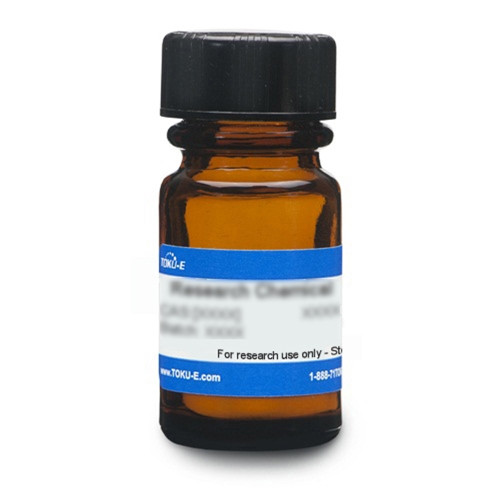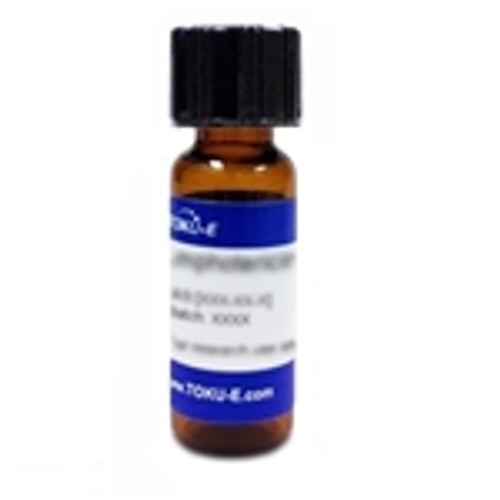Cefpirome Sulfate is the sulfate salt of Cefpirome, a semisynthetic, broad-spectrum, fourth-generation cephalosporin antibiotic that inhibits bacterial cell wall synthesis. Cefpirome is a β-lactam antibiotic consisting of a β-lactam ring bound to a dihydrothiazine ring. This two-ring system distorts the β-lactam amide bond, resulting in increased reactivity.
Cefpirome Sulfate is slightly soluble in DMSO.
We also offer:
- Cefpirome Sulfate Solubilized (C055)
| Mechanism of Action | Like other β-lactams, cephalosporins interfere with PBP (penicillin binding protein) activity involved in the final phase of peptidoglycan synthesis. PBP’s are enzymes which catalyze a pentaglycine crosslink between alanine and lysine residues providing additional strength to the cell wall. Without a pentaglycine crosslink, the integrity of the cell wall is severely compromised and ultimately leads to cell lysis and death. Resistance to cephalosporins is commonly due to cells containing plasmid encoded β-lactamases. The relative lack of cross-resistance between Cefpirome and the third generation cephalosporins suggests a slightly different mechanism of action of Cefpirome in comparison to the other cephalosporins. Due to its compact dipolar structure, Cefpirome can penetrate Gram-negative bacteria more quickly than the other agents (Nikaido et al, 1990) |
| Spectrum | Cefpirome is a broad-spectrum antibiotic targeting a wide variety of Gram-positive and Gram-negative bacteria. A relatively low affinity of Cefpirome for lactamases is considered to be one of the reasons for its high antimicrobial activity against such enzyme-producing strains (Nikaido et al, 1990). Many Bacteroides, Enterococci, and Haemophilus species have developed resistance to Cefpirome. |
| Microbiology Applications | Cefpirome Sulfate is commonly used in clinical in vitro microbiological antimicrobial susceptibility tests (panels, discs, and MIC strips) against Gram-positive and Gram-negative microbial isolates. Medical microbiologists use AST results to recommend antibiotic treatment options. Representative MIC values include:
|
| Cancer Applications | Cefpirome was found to be more effective than ceftazidime, aztreonam, timentin, and piperacillin against nosocomially important isolates during in vitro examination of 253 bacterial isolates from cancer patients (Rolston et al, 1986). |
| Molecular Formula | C22H22N6O5S2 · H2SO4 |
| Impurities | Single Impurity: ≤0.2% Total Impurities: ≤1.0% |
| Identification | HPLC, precipitate from reaction of calcium hydroxide TS, test for Na |
| References |
Cefpirome Sulfate (TOKU-E) was used in: Discerning strain-specific β-lactam drug resistance by clonal isolates of multi-drug resistant Pseudomonas aeruginosa using selected reaction monitoring (Spinler et al, 2019). |
| MIC | Aeromonas spp.| 0.015 - 2|| Bacteroides distasonis (ampicillin-resistant + cefazolin-resistant)| 16 - >32|| Bacteroides fragilis| 4 - 128|| Bacteroides melaninogenicus (ampicillin-resistant + cefazolin-resistant)| 16 - >32|| Bacteroides ovatus (ampicillin-resistant + cefazolin-resistant)| 16 - >32|| Bacteroides septicum (ampicillin-resistant + cefazolin-resistant)| 16 - >32|| Bacteroides thetaiotaomicron (ampicillin-resistant + cefazolin-resistant)| 16 - >32|| Bordetella pertussis | 0.25 - 0.5|| Burkholderia cepacia| 16 - >128|| Campylobacter jejuni| 0.5 - 8|| Citrobacter diversus (ampicillin-resistant)| 0.015 - 0.03|| Citrobacter freundii| 0.015 - >100|| Clostridium perfringens| 0.25 - >16|| Enterobacter aerogenes (ampicillin-resistant + cefazolin-resistant)| 0.03 - 1|| Enterobacter cloacae| 0.013 - 100|| Enterobacteriaceae| 0.008 - 32|| Enterococci| 1 - 128|| Enterococcus faecalis| 2 - 128|| Enterococcus faecium| 1 - >128|| Escherichia coli| 0.013 - 2|| Haemolytic streptococci| 0.004 - 0.12|| Haemophilus influenzae| 0.016 - 0.5|| Haemophilus spp.| 0.008 - 0.5|| Klebsiella aerogenes (1522 E)| 0.025|| Klebsiella oxytoca (ampicillin-resistant)| 0.03 - 1|| Klebsiella pneumonia| 0.015 - >256|| Klebsiella spp.| 0.015 - 2|| Listeria monocytogenes (cefazolin-resistant)| 1 - 32|| Moraxella catarrhalis| 0.03 - 4|| Morganella morganii| 0.015 - 0.5|| Neisseria spp.| 0.001 - 0.12|| Pasteurella multocida| <8|| Pneumococci| 0.008 - 1|| Proteus mirabilis| 0.015 - 0.5|| Proteus vulgaris| 0.03 - 8|| Providencia rettgeri| 0.008 - 8|| Providencia stuartii| 0.03 - 0.5|| Pseudomonas aeruginosa| 0.0781 - >128|| Pseudomonas cepacia (ampicillin-resistant + cefazolin-resistant)| 0.12 - >64|| Pseudomonas spp.| 0.25 - 128|| Salmonella spp.| 0.015 - 3|| Salmonella typhi| 0.015 - 0.12|| Salmonella typhimurium| 0.025|| Serratia marcescens| 0.03 - >100|| Shigella sonnei| 0.015 - 0.25|| Shigella spp. (ampicillin-resistant)| 0.015 - 0.5|| Staphylococci| 0.06 - 128|| Staphylococcus aureus (285)| 0.098 - 64|| Staphylococcus epidermidis (methicillin-resistant)| 0.125 - 64|| Staphylococcus saprophyticus| 0.5 - 16|| Streptococci (group F + group G)| 0.015 - 0.25|| Streptococcus agalactiae| 0.015 - 0.063|| Streptococcus pneumonia (penicillin-resistant)| 0.008 - 2|| Streptococcus pyogenes| 0.007 - 1.563|| Xanthomonas maltophilia| 4 - >64|| Yersinia enterocolitica| 0.015 - 0.12|| |







